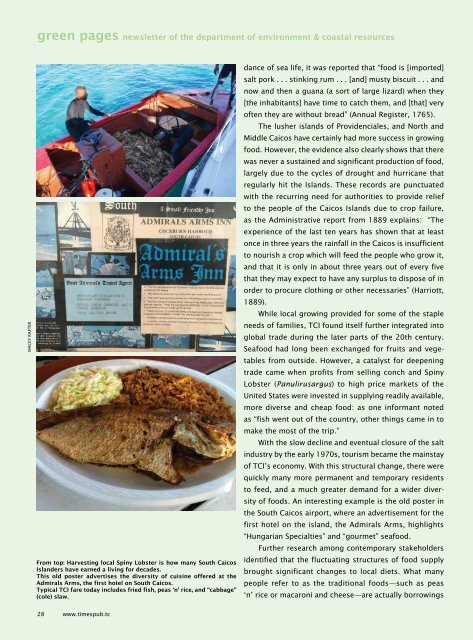Times of the Islands Fall 2016
Presents the "soul of the Turks & Caicos Islands" with in-depth features about local people, culture, history, environment, businesses, resorts, restaurants and activities.
Presents the "soul of the Turks & Caicos Islands" with in-depth features about local people, culture, history, environment, businesses, resorts, restaurants and activities.
Create successful ePaper yourself
Turn your PDF publications into a flip-book with our unique Google optimized e-Paper software.
green pages newsletter <strong>of</strong> <strong>the</strong> department <strong>of</strong> environment & coastal resources<br />
MACEY RAFTER<br />
From top: Harvesting local Spiny Lobster is how many South Caicos<br />
Islanders have earned a living for decades.<br />
This old poster advertises <strong>the</strong> diversity <strong>of</strong> cuisine <strong>of</strong>fered at <strong>the</strong><br />
Admirals Arms, <strong>the</strong> first hotel on South Caicos.<br />
Typical TCI fare today includes fried fish, peas ‘n’ rice, and “cabbage”<br />
(cole) slaw.<br />
dance <strong>of</strong> sea life, it was reported that “food is [imported]<br />
salt pork . . . stinking rum . . . [and] musty biscuit . . . and<br />
now and <strong>the</strong>n a guana (a sort <strong>of</strong> large lizard) when <strong>the</strong>y<br />
[<strong>the</strong> inhabitants] have time to catch <strong>the</strong>m, and [that] very<br />
<strong>of</strong>ten <strong>the</strong>y are without bread” (Annual Register, 1765).<br />
The lusher islands <strong>of</strong> Providenciales, and North and<br />
Middle Caicos have certainly had more success in growing<br />
food. However, <strong>the</strong> evidence also clearly shows that <strong>the</strong>re<br />
was never a sustained and significant production <strong>of</strong> food,<br />
largely due to <strong>the</strong> cycles <strong>of</strong> drought and hurricane that<br />
regularly hit <strong>the</strong> <strong>Islands</strong>. These records are punctuated<br />
with <strong>the</strong> recurring need for authorities to provide relief<br />
to <strong>the</strong> people <strong>of</strong> <strong>the</strong> Caicos <strong>Islands</strong> due to crop failure,<br />
as <strong>the</strong> Administrative report from 1889 explains: “The<br />
experience <strong>of</strong> <strong>the</strong> last ten years has shown that at least<br />
once in three years <strong>the</strong> rainfall in <strong>the</strong> Caicos is insufficient<br />
to nourish a crop which will feed <strong>the</strong> people who grow it,<br />
and that it is only in about three years out <strong>of</strong> every five<br />
that <strong>the</strong>y may expect to have any surplus to dispose <strong>of</strong> in<br />
order to procure clothing or o<strong>the</strong>r necessaries” (Harriott,<br />
1889).<br />
While local growing provided for some <strong>of</strong> <strong>the</strong> staple<br />
needs <strong>of</strong> families, TCI found itself fur<strong>the</strong>r integrated into<br />
global trade during <strong>the</strong> later parts <strong>of</strong> <strong>the</strong> 20th century.<br />
Seafood had long been exchanged for fruits and vegetables<br />
from outside. However, a catalyst for deepening<br />
trade came when pr<strong>of</strong>its from selling conch and Spiny<br />
Lobster (Panulirusargus) to high price markets <strong>of</strong> <strong>the</strong><br />
United States were invested in supplying readily available,<br />
more diverse and cheap food: as one informant noted<br />
as “fish went out <strong>of</strong> <strong>the</strong> country, o<strong>the</strong>r things came in to<br />
make <strong>the</strong> most <strong>of</strong> <strong>the</strong> trip.”<br />
With <strong>the</strong> slow decline and eventual closure <strong>of</strong> <strong>the</strong> salt<br />
industry by <strong>the</strong> early 1970s, tourism became <strong>the</strong> mainstay<br />
<strong>of</strong> TCI’s economy. With this structural change, <strong>the</strong>re were<br />
quickly many more permanent and temporary residents<br />
to feed, and a much greater demand for a wider diversity<br />
<strong>of</strong> foods. An interesting example is <strong>the</strong> old poster in<br />
<strong>the</strong> South Caicos airport, where an advertisement for <strong>the</strong><br />
first hotel on <strong>the</strong> island, <strong>the</strong> Admirals Arms, highlights<br />
“Hungarian Specialties” and “gourmet” seafood.<br />
Fur<strong>the</strong>r research among contemporary stakeholders<br />
identified that <strong>the</strong> fluctuating structures <strong>of</strong> food supply<br />
brought significant changes to local diets. What many<br />
people refer to as <strong>the</strong> traditional foods—such as peas<br />
‘n’ rice or macaroni and cheese—are actually borrowings<br />
28 www.timespub.tc

















